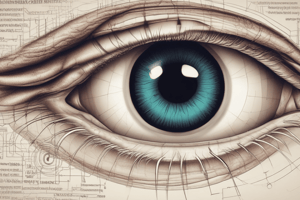Podcast
Questions and Answers
What are the two main branches of the common carotid artery, and what structures do they supply?
What are the two main branches of the common carotid artery, and what structures do they supply?
The two main branches of the common carotid artery are the internal carotid artery, which supplies structures internal to the skull, and the external carotid artery, which supplies structures external to the skull, including a small portion of the ocular adnexa.
What is the significance of the Circle of Willis in maintaining blood flow to the brain?
What is the significance of the Circle of Willis in maintaining blood flow to the brain?
The Circle of Willis is a cerebral arterial circle that provides equal blood pressure and alternative routes for blood flow in the event of a clot or blockage, ensuring continued blood supply to the brain.
What are the main branches of the ophthalmic artery, and what structures do they supply?
What are the main branches of the ophthalmic artery, and what structures do they supply?
The main branches of the ophthalmic artery include the central retinal artery, lacrimal artery, posterior ciliary arteries, and muscular arteries, which supply the retina, lacrimal gland, and ocular adnexa.
What is the function of the Blood-Retina Barrier, and how is it maintained?
What is the function of the Blood-Retina Barrier, and how is it maintained?
What are the two main types of branches that the central retinal artery subdivides into, and what is the significance of this branching pattern?
What are the two main types of branches that the central retinal artery subdivides into, and what is the significance of this branching pattern?
What is the effect of aging on the retinal circulation, and how does this lead to changes in the Blood-Retina Barrier?
What is the effect of aging on the retinal circulation, and how does this lead to changes in the Blood-Retina Barrier?
What is the age-related change in retinal microcirculatory flow, leading to tissue perfusion?
What is the age-related change in retinal microcirculatory flow, leading to tissue perfusion?
What is the predictor of age-related macular degeneration (AMD), especially its atrophic form (dry AMD)?
What is the predictor of age-related macular degeneration (AMD), especially its atrophic form (dry AMD)?
What is the main artery that supplies the choroid?
What is the main artery that supplies the choroid?
What is the site of anastomosis between the long posterior ciliary arteries and anterior ciliary arteries?
What is the site of anastomosis between the long posterior ciliary arteries and anterior ciliary arteries?
What is the function of the supratrochlear artery?
What is the function of the supratrochlear artery?
What is the blood supply to the extraocular muscles?
What is the blood supply to the extraocular muscles?
What is the function of the lacrimal artery?
What is the function of the lacrimal artery?
What is the characteristic of the veins draining the globe and orbit?
What is the characteristic of the veins draining the globe and orbit?
What is the age-related change in the pericyte basement membrane?
What is the age-related change in the pericyte basement membrane?
What is the function of the central retinal artery?
What is the function of the central retinal artery?
Flashcards are hidden until you start studying
Study Notes
Blood Supply to the Eye and Adnexa
- The blood supply to the head and neck originates from the arch of aorta, which divides into brachiocephalic trunk, left common carotid, and right subclavian and right common carotid arteries.
- The common carotid arteries further divide into internal carotid and external carotid arteries.
- The external carotid artery has 9 branches, including branches that supply the ocular adnexa.
Ophthalmic Artery
- The ophthalmic artery arises from the internal carotid artery and has several branches:
- Central retinal artery
- Lacrimal artery
- Posterior ciliary arteries (short and long)
- Muscular arteries
- Ethmoid arteries
- Supraorbital artery
- Medial palpebral arteries
- The central retinal artery pierces the optic nerve and divides into superior and inferior branches, which further subdivide into nasal and temporal branches.
- The central retinal artery provides blood supply to the optic nerve and pia matter.
Retinal Circulation
- The retinal circulation has a blood-retina barrier formed by tight junctions between RPE cells and endothelial cells of retinal capillaries.
- Autoregulation maintains constant blood flow despite changes in intraocular pressure and systemic blood pressure.
- Age-related changes in retinal circulation include:
- Loss of cells at capillaries
- Thickening of pericyte basement membrane
- Narrowing of vascular lumens
- Decreased capillary number in the macula
- Decreased blood flow in people over 50 years old
Choroid and Bruch's Membrane
- The choroid receives blood supply from the posterior ciliary arteries.
- Age-related changes in Bruch's membrane include thickening, decreased permeability, and accumulation of extracellular debris (drusen).
- Drusen are a predictor of age-related macular degeneration (AMD).
Extraocular Muscles
- The extraocular muscles receive blood supply from muscular arteries that branch from the arteries supplying the recti muscles.
- The lateral-superior artery supplies the lateral rectus, superior rectus, superior oblique, and levator muscle.
- The medial-inferior artery supplies the medial rectus, inferior rectus, and inferior oblique.
Lacrimal Gland and Eyelids
- The lacrimal gland receives blood supply from the lacrimal artery, which also supplies the lateral rectus muscle and sends branches to the conjunctiva and eyelids.
- The medial palpebral arteries supply the eyelids and anastomose with branches from the lacrimal artery to form palpebral arcades.
- The dorsonasal artery supplies the lacrimal sac and anastomoses with the angular artery from the external carotid.
Studying That Suits You
Use AI to generate personalized quizzes and flashcards to suit your learning preferences.




